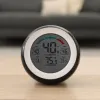In recent years, radon testing has become standard practice among prospective homeowners after placing a property under contract. It’s also common for longtime homeowners to perform a radon test — especially if their home was never tested in the past or they live in an area where elevated radon levels are common.
Radon exposure, after all, is the leading cause of lung cancer among non-smokers. When indoor concentrations of radon are high, it’s not something you should live with. It’s something you need to mitigate.
So, can an ERV lower radon levels in your home?
Yes. In most homes, most of the time, an energy recovery ventilator, or ERV, can reduce indoor radon levels. An ERV is a mechanical ventilation device that provides fresh air to your entire home. It looks like this:
ERVs are virtually always hidden away in a basement, crawlspace, or utility closet. We’ll go over how they work in just a bit — and how they lower radon levels — but the thing to know when it comes to radon is that installing an ERV is a reliable way to reduce levels in most homes.
But most people don’t use an ERV to deal with radon. The most common solution is still the oldest solution: installing a dedicated radon mitigation system.
Radon mitigation systems consist of PVC pipes and a powerful fan. Typically, a contractor will dig one or more holes below your house, install PVC pipes inside the holes, and run those PVC pipes outside. A special fan inside the pipes pulls soil gases, such as radon, from beneath the home’s foundation and releases them outside.
From outside the home, most radon mitigation systems look like this:
The bulge in the PVC pipe is for the fan. Soil gases are sent up the outdoor pipe and released into the air at a point above the home’s roofline.
Depending on your home’s attributes, it might be really easy or really difficult to install one of these systems. Basement installations will involve drilling through your basement floor to install the pipes, and possibly in multiple parts of your basement. Crawlspace installations may be more straightforward… unless you’ve got a really small crawlspace with minimal clearance. Then things could get complicated. Costly, too.
For these reasons — and the fact that you may find a radon mitigation system unsightly — you should consider an ERV as an alternative solution to your radon problem or a complement to an existing radon removal system.
An ERV also provides additional benefits beyond radon mitigation. That’s why lots of homeowners install them even when they’re not trying to address a radon issue.
First things first, are the radon levels in your home too high?
They might be. You’ll have to perform a test to check.
Radon mitigation companies use special equipment to perform a radon test in your home. Typically, they prefer to set up the equipment while nobody is living in the home or while you’re on vacation for a few days. They want to get a reading of radon levels while you’re not opening doors, using bath fans, or otherwise ventilating the space.
If the radon level in your home measures 4 pCi/L or higher, you’ll need to mitigate it somehow. That’s the EPA’s recommended level for installing equipment that lowers your home’s radon levels.
When your radon level is lower than 4 pCi/L, you usually have nothing to worry about. However, if you’re close to that cutoff level, your radon mitigation contractor might recommend a second test later in the year. That’s because temperature, barometric pressure, and precipitation can impact how much radon enters the home. Your home might have low levels at one time of year and higher levels at another time.
Homeowners with radon levels that exceed the EPA threshold will need to choose between a traditional radon mitigation system and an ERV. The choice is up to you, but it’s important to know how both systems work so you can make an informed decision.
How does an ERV work?
An ERV provides ventilation to a home or building. It’s similar to a heat recovery ventilator (HRV), although an ERV does a little something extra.
Both ERVs and HRVs provide balanced ventilation to a home. That means they bring fresh air into the living space and expel stale, “used” indoor air from the home in equal amounts. HRVs transfer heat between the two air streams. On warm days, this means that some of the heat from the incoming air stream is transferred to the outgoing air. As such, the fresh air entering the home isn’t as hot as the outdoor air. This works in reverse in the winter, which is why HRVs are mostly popular in colder climates.
ERVs transfer heat like HRVs, but they also transfer moisture.
If you’re wondering whether to get an HRV or ERV, it mostly comes down to whether you live in a humid climate or not. Here in Atlanta, an ERV is always going to be preferable!
With an ERV, the incoming fresh air will not be as humid as the air outside because some of the moisture has been transferred to the outgoing airstream. So, you get fresh air ventilation without as big of a humidity penalty as you might think.
How an ERV helps reduce radon levels in your home
A typical radon mitigation system works by removing radon directly from the ground beneath your home. An ERV removes radon by constantly replacing radon-laden air with air that doesn’t contain radon.
With an ERV, you don’t remove radon from the source. Radon can still rise from the ground beneath your home and enter your living space. But since the ERV runs constantly and is always replacing indoor air with fresh outdoor air, only limited amounts of radon circulate throughout your home at any given time.
In most cases, an ERV can reduce indoor radon levels to a level that poses no known hazard to human health.
And it does so without complicated piping beneath your house or unsightly exterior components. Most ERV installations integrate easily with existing HVAC ductwork and leave a minimal footprint outside the home — just a ventilation flap similar to what you have for your dryer vent.
Did we mention that ERVs also have benefits beyond radon mitigation?
Additional benefits of ERV systems
Most people don’t install ERVs for their radon-reducing capabilities. ERVs are most often installed in high-performance homes as a way to control and optimize ventilation.
Compared to the passive “ventilation” most homes get from their leaky building envelope, homes with ERVs benefit from:
- Ventilation that doesn’t pressurize the home
- Constant ventilation, so the air you breathe is always fresh
- Filtered ventilation that prevents the entry of airborne environmental allergens
- Improved humidity management since the ERV removes some of the humidity from the incoming air before it enters the home
We actually think an ERV is the best way to ventilate your home, all things considered. While they’re most popular for tightly sealed, high-performance construction, an ERV can be a great upgrade for anybody who cares a lot about indoor air quality!
Worried about radon? Here’s what to do.
Contact a radon mitigation contractor in your area. Yes, consumer-grade radon tests are available, but dedicated radon specialists have the best equipment and can collect the most accurate readings. This is an important matter, so you don’t want to skimp!
If your radon levels exceed 4 pCi/L, you’ll need to get a radon mitigation system or an ERV. The right decision for your home will be a combination of priorities, cost, and overall benefits to your home and your family.
When you’re ready to install an ERV for your Atlanta area home, get in touch with us! We’ll visit your home to hear all about your concerns and answer all your questions. After that, we’ll help you choose the right ERV and provide top-notch, fully audited installation. To find out more, get in touch with us today!






